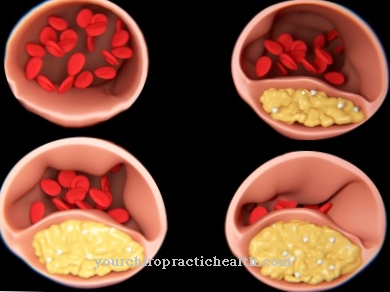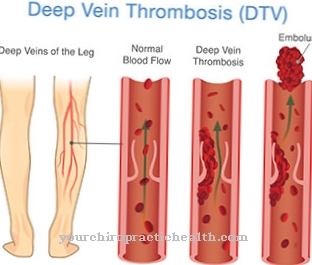At a Esophageal variceal bleeding there is bleeding from varicose veins within the esophagus. It is classified as a medical emergency and is life threatening.
What is esophageal variceal bleeding?
As Esophageal varices are called varicose veins (varices) in the gullet (esophagus). They mostly arise from portal hypertension (portal hypertension). Esophageal varices cause the veins within the esophagus to widen. Often they are a complication of advanced liver cirrhosis.
But other diseases can also be responsible for the occurrence of esophageal varices. In the context of liver cirrhosis, esophageal varices are found in around 50 percent of all patients. If the esophageal varices bleed, around 30 percent of all affected people die despite medical treatment. The risk of recurrence of bleeding in the esophagus is around 70 percent.
causes
Esophageal variceal bleeding is caused by a tear in the varices in the esophagus. The varicose veins in the esophagus form when the blood cannot properly drain from the liver, as in the case of advanced cirrhosis. The blood looks for an alternative circuit towards the heart. This creates increased pressure in the hepatic veins, which leads to a build-up of blood in the liver. Doctors then speak of portal hypertension.
So that the blood can still be transported to the heart, the blood looks for other paths through existing collateral circuits. The heavy stress that this creates ultimately results in the formation of varicose veins. Esophageal variceal bleeding sets in with external injuries to the thin vessel wall.
These can be caused by solid foods, among other things. Another trigger is increased vascular pressure during bowel evacuation, which leads to abdominal cramps. The varicose veins do not have muscles that are strong enough to regulate and stop the bleeding. This prevents the large amount of blood from getting past the liver.
This in turn causes the esophageal veins to sag. As the process progresses, the veins thin out more and more until they finally burst. There are several risk factors for esophageal variceal bleeding. These include the consumption of alcohol despite cirrhosis of the liver, the existence of extensive esophageal varices and bleeding in the esophagus that has already been suffered.
Symptoms, ailments & signs
Symptoms of esophageal varices appear late. They are characterized by esophageal variceal bleeding, in which patients suddenly vomit blood. The blood is gushing and in large quantities. It can also flow directly from the esophagus into the stomach, which in turn creates tarry stools.
Because the blood comes into contact with hydrochloric acid in the stomach, it turns black due to chemical changes. Another indication of esophageal variceal bleeding is pale skin on the affected person, which is due to significant blood loss. This causes the blood pressure to drop.
The esophageal variceal bleeding is considered to be life-threatening and represents a medical emergency. There is a risk that the patient will die in a short time. The bleeding in the esophagus is the leading cause of death in liver cirrhosis. The more cirrhosis of the liver has progressed, the greater the risk of death from bleeding from the esophageal varices.
Diagnosis & course of disease
Endoscopy is usually performed to diagnose bleeding esophageal varices. For this purpose, the doctor inserts a thin tube equipped with a camera into the esophagus via the oral cavity. With the help of a connected monitor, the doctor is able to examine the lining of the esophagus and identify the esophageal varices.
It is also important to have a differential diagnosis of other causes that may be causing bleeding in the gastrointestinal tract. This can be inflammation of the lining of the stomach or stomach ulcers. It is not uncommon for esophageal variceal bleeding to take a negative course despite hemostasis.
Around 30 percent of all patients die from it. In most cases, the reason for this is shock due to the massive bleeding. Even if the first bleeding is survived, around a third of those affected will die of recurrent bleeding.
Complications
Esophageal variceal bleeding is an extremely life-threatening emergency. Even with treatment, there is a high death rate. Even under therapy, up to 30 percent of all patients die. Without treatment, the mortality is of course much higher and is almost 100 percent.
Usually it is a very massive bleeding when the varicose veins in the esophagus, which are bulging with blood, break open. Life-threatening blood loss occurs, which can only be stopped by quickly clamping or sclerosing the affected varices. Even if the bleeding is stopped, another 30 percent of those affected die from recurrent bleeding.
The causes of the often lethal course of esophageal variceal bleeding are, in addition to the high blood loss and the resulting loss of fluid, also attacks of suffocation, pneumonia due to blood aspiration when inhaled or the development of sepsis with multiple organ failure. Since esophageal variceal bleeding is usually caused by severe cirrhosis of the liver, other serious and sometimes fatal complications often occur.
Esophageal variceal bleeding can only be treated symptomatically in the acute stage. With the help of this therapy, only its immediate effects can be prevented. A real cure is only possible with the help of curative treatment of the liver failure. If the cause is not eliminated, recurrent bleeding will occur again and again. Sometimes the only way to save a patient's life is with the help of a liver transplant.
When should you go to the doctor?
Vomiting blood or sudden, acute changes in health are considered to be of great concern. Since esophageal variceal bleeding is an emergency, immediate medical attention must be obtained. If the person concerned notices abnormalities in the area of the esophagus, if there is a sudden decrease in well-being or if they feel sick, a doctor should be consulted. If you have internal weakness, pale skin or abnormalities when using the toilet, action is required. Blood in the urine or stool are alarm signals for the organism.
If locomotion is impaired, if the person concerned experiences a loss of physical capacity or if they complain of muscle weakness, a doctor must be consulted as soon as possible. If left untreated, the disease can lead to premature death. There is internal bleeding which leads to a loss of internal strength. If the person concerned can no longer carry out his usual physical activities without help or discomfort, he needs help. In acute cases, an ambulance service must be alerted and first aid measures must be applied in parallel. A change in the state of health within a few minutes is characteristic. Low blood pressure, a delay in the usual ability to react and cognitive losses or disorientation should therefore be examined and treated as soon as possible.
Treatment & Therapy
Immediate medical care is required in the event of esophageal variceal bleeding as this is extremely dangerous. One of the most important therapeutic measures is the stabilization of the circulatory system, because the patient loses a lot of blood and fluid in a short time. To counteract this condition, the sick person is given fluids intravenously.
A blood transfusion can also be performed if necessary. In addition, an attempt is made to stop the bleeding. The doctor usually performs an endoscopic ligature. This means that it ties off the esophageal varices using plastic clips. Medicinal hemostasis is also possible. For this purpose, the patient is given drugs such as somatostatin or terlipressin.
They have a lowering effect on the blood pressure within the portal vein system. If the bleeding is profuse, there is an option to insert a balloon tamponade into the lower esophagus. The doctor inflates the balloon in the esophagus, which compresses the blood vessels. However, because the risk of complications is considered high, endoscopy or the administration of medication are primarily used.
Another part of the therapy is the administration of antibiotics. In this way a possible infection with bacteria is counteracted. Therefore, the patient is given ciprofloxacin for a few days. If the esophageal variceal bleeding occurs in connection with cirrhosis of the liver, it is important to prevent a hepatic coma.
prevention
Esophageal variceal bleeding cannot be prevented. For this reason, it is important to treat underlying diseases that cause them in good time.
You can do that yourself
If there is a taste of blood in the back of the throat, see a doctor immediately. Esophageal variceal bleeding is a medical emergency. Self-help measures are not enough to be able to provide adequate health care on one's own responsibility.
Sick people should pay more attention to the intake of their food in the future. Food containing pointed or sharp elements should not be consumed under any circumstances. They include, for example, bones in fish, crispbread or rusks. These could damage the esophagus. In addition, it is essential to ensure that the purchase process is optimized. Ingested food is sufficiently ground in the mouth through the teeth before it is moved down the throat. Before that, it should be chopped into small pieces as possible.
In the event of a drop in blood pressure, weakness or general malaise, a doctor should be consulted immediately or the emergency services should be alerted. There is a potential danger to life which makes medical care as soon as possible necessary.
In addition, physical activities that exert a heavy load on the organism are to be avoided. The organization of leisure time and sporting activities should be optimized by those affected on the basis of the possibilities of the organism.


.jpg)
.jpg)























